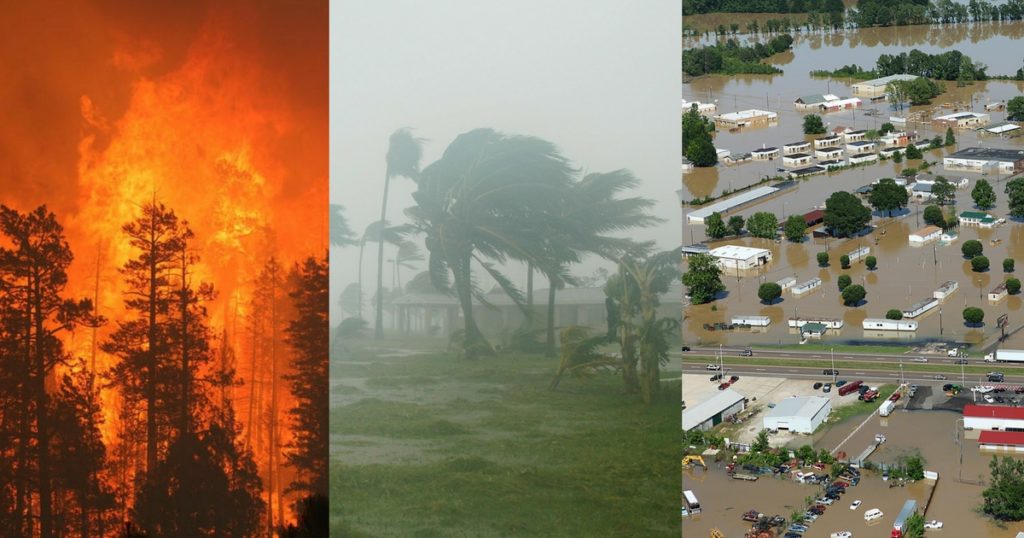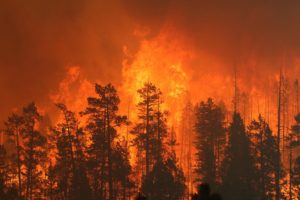
Are You Ready For A Natural Disaster in Arizona?
As of this writing, Texas is still cleaning up from record rainfalls and flooding from Hurricane Harvey. At the same time, dozens of wildfires are raging in the northwest due to dry conditions and extreme heat. Now Hurricane Irma threatens the southeastern U.S. as one of the most intense storms ever recorded.

Flames from the Wallow Fire (Arizona’s largest-ever wildfire—consume pine trees in 2011. Photo provided by Apache-Sitgreaves National Forests.
Although Arizona is not likely to face a hurricane, we are not immune to natural disasters. Seven years ago (October 5-6, 2010), three supercells resulted in 8 tornadoes that touched down around the town of Bellemont, near Flagstaff. Earlier that same day, severe hailstorms damaged 150,000 homes and caused $2.81 billion damage in the Phoenix metro area. Some hailstones were 3 inches in diameter, the size of baseballs. Here is a video of one homeowner’s experience:
Even though the risk of natural disasters may be lower in some areas of the country than in others, the bottom line is no one is immune from Mother Nature’s wrath. Most people think preparing for a natural disaster means buying some canned goods and a few cases of bottled water. Preparation, however, should be a continuous state-of-mind, not a one-time fear motivated shopping trip. Here are three questions you should consider:
- Do you know the natural disaster risks for your area?
- Do your existing insurance policies adequately cover those risks?
- Do you have a plan of action if you lost your home or had to evacuate your family?
What are your known risks?
Make a list of all known risks wherever you own property. Here in Phoenix, the most common natural disasters would likely be drought, a prolonged heat-wave, a severe hailstorm, or flooding. Tornadoes and earthquakes are rare, but could still happen. In 2001, a minor earthquake in Baja Mexico (about 50 miles southwest of Yuma) was felt by residents of Phoenix. It was a novelty event and we laughed about the pool splashing over the edge. But it became more serious when we realized that our stucco fence was now full of cracks.
If you live (or have a vacation home) near a forest, wildfires are one of your biggest concerns. Not all carriers will cover a home or cabin in a forested area. Some will even make inspections to make sure that brush is cleared away and that fire hazards have been moved away from the structure.
What does standard insurance cover?
When you compare insurance policies, make sure you look beyond just the premium. There are many variables to consider. Also remember that no matter how comprehensive your policy, if you fail to take reasonable precautions to maintain your home and protect it from damage, your insurance carrier may deny claims.
Most basic homeowners insurance policies cover the following:
- Fire or lightning
- Windstorm or hail
- Explosion
- Riot or civil commotion
- Damange caused by aircraft
- Damage caused by vehicles
- Smoke
- Vandalism or malicious mischief
- Theft
- Volcanic eruption
You may have to pay a higher premium for a policy that covers:
- Falling Object
- Weight of ice, snow or sleet
- Plumbing leaks
- Sewer back-up
- Floods
- Earthquakes
- War
- Nuclear accident
- Landslide, mudslide, sinkhole.
Flood coverage is available from the National Flood Insurance Program (NFIP) and from a few private insurers. It is available for renters as well as homeowners. You need flood insurance if you live in a designated flood zone, but also consider buying it if your house could be flooded by melting snow, an overflowing creek or water running down a steep hill. Don’t wait until a storm is approaching to buy a policy. There is a 30-day waiting period before federal flood coverage takes effect.1
Earthquake insurance is available from most carriers and is usually a separate policy or an endorsement to your homeowners or renters policy. In areas that are prone to earthquakes (such as California), the policy comes with a high deductible.
Create an Emergency Plan of Action
There are things you can do now that will be extremely helpful should you face a personal or natural disaster. Important documents can be scanned and saved in Dropbox (or another “cloud” program) which would allow you to access it from anywhere.
- Take pictures or make a video of your home and its contents.
- Document all valuable items or collections. Be specific about descriptions, date purchased, estimated value, etc.
- Determine a friend or relative you could stay with if there were a natural disaster in your area or if you had to evacuate. (Hotels fill up quickly.) Would you be able to bring your pets?
- Make a list of things that would be most important to take if you had to make a quick get-away. This would include baby supplies, medications, etc.
- Make a list of keepsakes or photos and documents that are of highest priority if you had time to pack a few possessions.
It’s not fun to think about facing a disaster and our prayers go out to those who are literally picking up the pieces of their lives in Texas and elsewhere. Taking time to plan for life’s risks won’t keep Mother Nature at bay, but it may help soften the financial hardship and stress that follows any type of disaster.
We have personally donated to a disaster relief organization and invite you to consider making a donation as well. For more information, go to www.redcross.org.
Sources:

